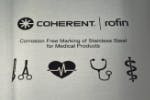Sub-Surface UDI Marking of Stainless Steel Medical Devices with Picosecond Lasers
There is a growing need to mark medical devices with a unique device identifier (UDI), driven in part by regulations such as the recent FDA rule impacting class II re-usable devices. Many devices are made from various stainless steels. The need is thus to mark these stainless surfaces with a high contrast high resolution mark that can be read automatically or by a human operator. The marks must be able to withstand repeated sterilization (i.e., autoclaving) without fading, and should be sub-surface as engraving could compromise their use as implantables, etc., and create possible contamination sites. And to simplify device fabrication and minimize overall costs, the marking process should not compromise the natural passivation of the stainless surfaces, thus requiring re-passivation.
Traditional laser marking techniques all fall short on one or more of these important requirements. For instance, nanosecond DPSS lasers can produce black marks. But these marks are based on oxidation. This requires a re-passivation step. Plus the marks fade with both re-passivation and autoclaving.
A fairly new process is now gaining fast adoption: producing black marks with a picosecond laser. With picosecond laser marking, a major contributor to the high contrast black appearance seems to be a sub-surface nanostructural change that results in efficient light trapping and light absorption, without significant change in the material composition. Tests at Coherent show that the marks are naturally resistant to corrosion (rusting) during repeated autoclaving, and do not require any re-passivation for this purpose. And second, neither passivation nor autoclaving cause any appreciable fading of these marks.
Black marks examples created on 1.4301 stainless steel using a Coherent Rapid NX picosecond laser incorporated in a PowerLine marking subsystem.
At the same time, next generation lasers such as the Rapid NX (https://go.coherent.com/l/191222/2018-09-28/d1btmq) from Coherent have dramatically improved the economics of marking with picosecond lasers which are now available as standalone lasers, marking subsystems, and complete turnkey tools with optional pre-optimized software.

